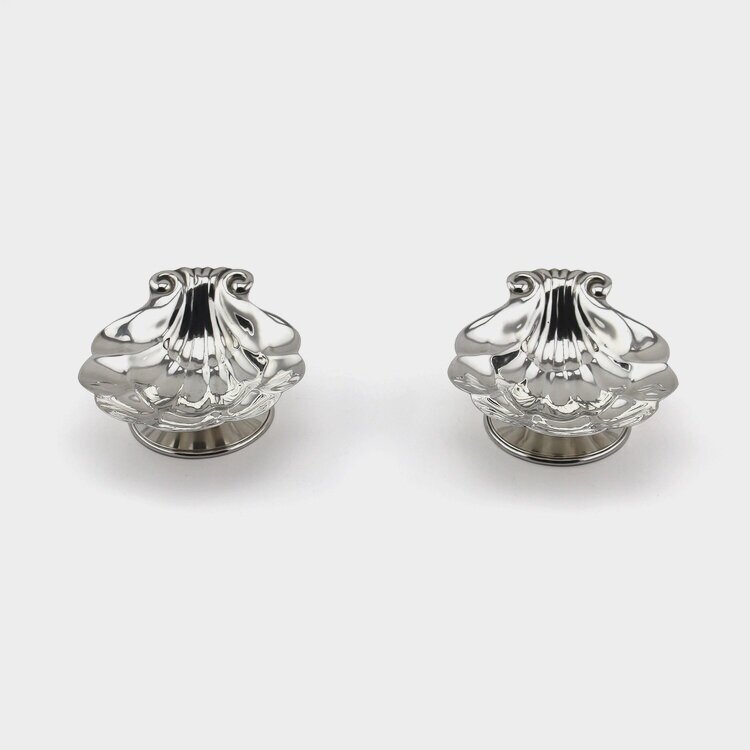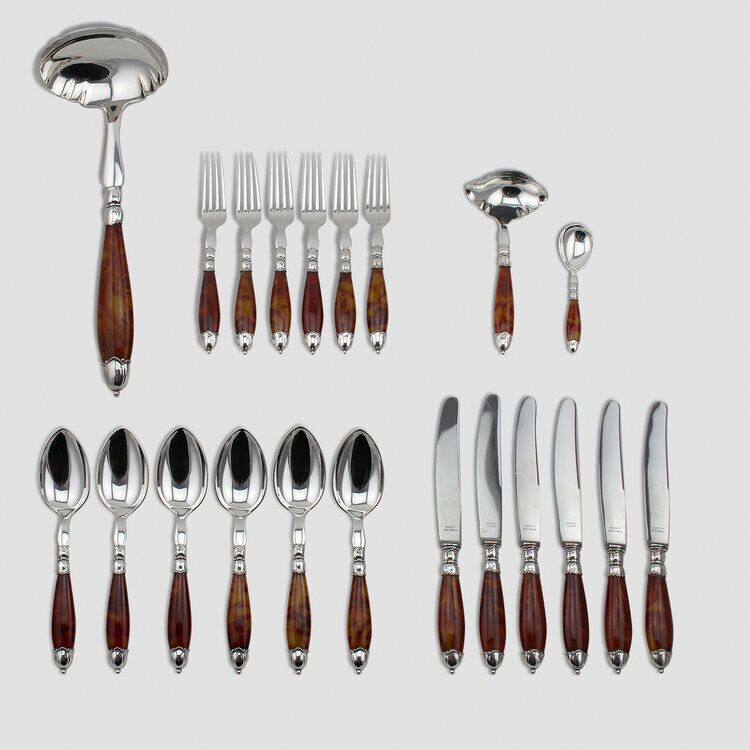History & Global Influence of Scandinavian Design
Scandinavian design, characterized by simplicity and functional minimalism, emerged in the early 20th century, flourished mid century and continues to be a major inspiration to this day. To understand the movement we must study what influences shaped key designers such as Georg Jensen and made them prolific disseminators of Scandinavian design.
Hans Dahl (Norwegian 1849-1937) ‘Young Girl on a Summer Alpine Stroll’, oil on canvas, signed lower right "Hans Dahl" Size: 26 ¼ x 39 in (with frame 34 ¾ x 47 ¼ in)
Scandinavia, encompassing the Nordic countries of Denmark, Sweden, Norway, Finland and Iceland, lacked a major cultural capital like Paris, London or Venice. Therefore, styles and new developments were often delayed in reaching the general population and subsequently industrialization came later than in other European nations. Many Scandinavian countries were still practising master and apprentice relationships, while at the same time in England there had already begun reactionary movements against industrialism. Prior to 1900, Scandinavia was known for strong craft traditions, drawn largely on national folklore for decorative inspiration, with Viking revival imagery being very popular.
Norwegian oval tine or pantry box, circa 1900. The sides are covered with several running ribbon designs while the top has a beautiful graceful scroll pattern
Size: 4 ½ h x 6 ½ w x 2 ½ d in.
Scandinavian box of dovetailed construction, probably Swedish, with sliding lid and original painted decoration in blue, inscribed with initials and dated "B.S.D 1844” Size: 18 ¾ h x 14 ½ w x 6 d in
By the last quarter of the 19th century, technological advancements meant that information and development moved more quickly, and the Scandinavian countries suddenly had the industrial knowledge and the artisan skills needed to produce the items sought after by their southern neighbours. The Great Nordic Exhibition of 1888 finally introduced Scandinavian design to the rest of Europe. It also provided Scandinavian artistic exposure to international movements such as Art Nouveau and Arts and Crafts. This was followed by the 1897 Stockholm Exhibition of Arts and Industries. The Exposition Universelle in Paris in 1900 further propelled Scandinavian design, where the Danish Museum of Art and Design presented an exhibition of Danish design alongside the porcelain pieces of the Swedish Rörstrand porcelain factory. The Rörstrand nationalistic design incorporating native flora and fauna into 3-dimensional pieces was a great success. It was at this time that Scandinavian artists began to be recognized in larger European publications. The young Danish artist Georg Jensen was mentioned in The Studio, a well-respected English publication, as early as 1902. Georg Jensen held a pivotal place in our collective culture, and the creation of a worldwide identity for Scandinavian design.
Two of Scandinavia’s largest porcelain manufacturers also embraced a combination of international and Scandinavian design. Royal Copenhagen and Bing & Grøndahl helped to expand Japanism as the style of the period. In the 1925 Paris Exposition des Arts Décoratifs et Industriels Modernes, Swedish design stole the show by taking 35 Grand Prix, 46 gold medals, 13 bronze medals and 13 honorable mentions, more than any other country. By the 1939 New York World’s Fair, Scandinavian style was cemented with Swedish and Danish Modern Style on display. It was through firms such as Georg Jensen, Royal Copenhagen, Bing and Grøndahl, Kosta and Orrefors, who hired the best of Scandinavian designers and craftsmen, that the world finally fully embraced Scandinavian design.
Blue Fluted Plain porcelain dinner set, Royal Copenhagen 65 pieces (+ 11) + Bing and Grøndahl 47 pieces (+ 30) = total 112 (+41 = 153) with various dates 1870-1973.
The difficulty accessing both material and markets during the second world war forced many companies to reinvent themselves. This resulted in home wares that were useful, minimalistic and well designed which won international acclaim. Influenced by the German Bauhaus School, designers incorporated industrial technologies into simple household objects. The Lunning Prize, awarded to outstanding Scandinavian designers between 1951 and 1970, was instrumental in defining the profile of Scandinavian design and making it a recognized commodity.
The story of Nordic design between 1940 and 1955 varies enormously with parallel events in America, due mainly to the relatively modest scale of Scandinavian industry and their continued commitment to tradition and the applied arts. Denmark and Finland had been especially careful to institute educational establishments to safeguard their craft traditions and, by mid-century, were aware of the need to integrate the craft process into commercial production in pursuit of what they called the industrial arts.
Several publications and exhibitions travelled through North America form 1954-1957 promoting Scandinavian Modern home decor, which became known for a tradition of high-quality craftsmanship. Following the iconic designs such as Poul Henningsen’s 1926 PH-lamps and Arne Jacobsen’s 1958 Egg Chair, designers such as Alvar Aalto and Hans Wegner helped to create a ‘golden age’ of Scandinavian Design. The emphasis was not just on furniture but incorporated architecture, silver, ceramics, glass and textiles, and today extends to such consumer goods as electronics, mobile phones and cars.
GEORG JENSEN (DANISH 1866-1935)
Pair of sterling silver tazzas decorated with grapes, Georg Jensen design from 1918. Spiral fluted stem, circular foot and hammered surface. Marked with Georg Jensen design no. 263B, circa 1933. Size 7 ½" high, diameter 7 1/8"
Born in 1866, Georg Jensen apprenticed as a knife grinder with his father before pursuing a career in sculpting. He studied at the Danish Royal Academy, graduating at the age of 25 and exhibiting at the Charlottenborg Exhibition in 1883. He turned his attention to the applied arts, working as a modeller at the Bing & Grøndahl porcelain factory and founding a small pottery workshop with a friend in 1898. It was not until 1904 that Jensen opened his own small silversmithy in Copenhagen. He was given a travel grant by the Danish Academy and spent two years touring the art centers of France and Italy. This exposed him to Art Nouveau which greatly influenced his work and developed his ambition to fuse beauty and function into his creations. In 1904, Jensen opened his own small silversmithy in Copenhagen. The same year, he exhibited his silverwork for the first time at the Museum of Decorative Art in Copenhagen. The exhibition was an immediate success and helped launch his business. He produced primarily jewellery in the early years, with the intention of creating affordable art for the middle classes while emphasizing the value of handmade craftsmanship over mass-produced goods.
Jensen’s identity evolved with the collaboration of innovative designers who responded to new technologies, materials, social practices and consumer tastes. Together with Christian Mohl Hansen they produced the dove brooch which became a motif in many of Jensen’s jewellery pieces and endures to this day. Jensen began creating hollowware, and in 1905 began what was to become one of his most important alliances with Johan Rohde. Rohde’s approach to design was cautious and methodical which complimented Jensen’s more romantic and impulsive approach. In 1916, Rohde designed the most famous of Jensen’s flatware patterns, acorn. Jensen also collaborated with the talents of Henning Koppel, Harald Nielsen, Sigvard Bernadotte and Oscar Gundlach-Pedersen, and the designs by Jensen’s brother-in-law Nielsen were almost indistinguishable from that of Jensen’s own style.
Johan Rohde for Georg Jensen. 'Cosmos' coffee service in light hammered sterling silver, embellished with fluting and stylized foliage, handle in fluted ebony. Consisting of: coffee pot (H.9.25".), sugar bowl with lid (H.4.25"), cream pitcher (H. 4.25"). Produced by Georg Jensen in the period 1915-1933. Design No.45, Total weight approx. 1,012 g
Jensen’s workshop gained a reputation for having a friendly, democratic atmosphere that was conducive to collaboration and a feeling of solidarity among the staff. Sales steadily grew and often pieces would sell out. He continued to expand throughout Europe and worldwide. Jensen’s reputation in the US was propelled by his solo exhibition at the Art Institute of Chicago in 1921, which was accompanied by an English language book. This led to the opening of a retail shop, and the American market loved his sophisticated, simple yet decorative pieces so much that they were in great demand. The company continued to thrive, and by the end of the 1920s, Jensen had retail outlets in New York, London, Paris, Stockholm, and Berlin. The success of his business life was unfortunately overshadowed by the death of three of his four wives in 1892, 1897 and the third from Spanish Influenza in 1918. The last decade of Jensen’s life was lined with professional accolades, although he grew increasingly alienated from the firm. He was awarded the Grand Prix at the Paris World’s Fair in 1925, the 1929 World’s Fair in Barcelona, and again in 1935 at the World’s Fair in Brussels. He was the only silversmith outside Great Britain to exhibit at the Goldsmith’s Hall in 1932. Georg Jensen passed away in 1935 at the age of 69.
Reinventing itself after the rationing of the second world war, the firm developed home wares redesigned for the modern era. Scandinavian Modern décor continued to be promoted throughout Europe and North America. The firm continues today with the same tradition of innovation, design and unparalleled craftsmanship which is still relevant.
Set of four ornamental sterling silver serving spoons, blossom pattern #21, with Georg Jensen marks after 1945
Size: 5 ¼ in
Here we can see the global influence of Georg Jensen design which embraced the Art Nouveau lines, but injected with a distinct vigour which still resonates today.
A Danish five branch silver candelabrum, maker G. Epel, inspired by Georg Jensen, with pierced stem, forged with beaded ornamentation, marked ‘EPEL 830S Denmark’, 830 silver standard. The silversmith G. Epel also worked as a maker and designer for Scandia Affineringsværk. Size: 5 3/4 h x 9 w x 9 d in
Carl Poul Petersen (Danish/Canadian 1895-1977) sterling silver comport, hand hammered, marked with Petersen mark and "Hand Made Sterling"
Carl Poul Petersen was born in 1895 and apprenticed with Georg Jensen for five years from when he was 13 years old. He became a Master Silversmith and married Jensen's daughter Inger in 1922. They moved to Montreal in 1929 and in 1932 he worked for Birks & Son as their Master goldsmith. Petersen worked on his own from 1937 to 1939, returned to Birks from 1939 until 1944, and resumed his store which was in operation until 1975. Petersen died in 1977.
Petersen was the primary silversmith to the Bronfman Family who were the richest family in Canada at the time. He worked with elite Canadian and American clients with specialty orders and crafted jewellery, 11 different flatware designs, tea sets, serving pieces, bar sets, and a line of Judaica. His work is highly collected in Canada and he is responsible for the current Stanley Cup which he was commissioned to redesign in 1962. His work closely resembles Georg Jensen's work from 1912 to 1923.
Danish silver flatware set comprising 21 pieces, stamped with marks for Copenhagen (1928) and assayer's mark for Christian F. Heise, with imitation amber handles, in fitted box
Georg Jensen USA sterling silver table lighter having a leaf and bead three dimensional design. Underside with impressed "GEORG JENSEN INC. U.S.A. L.P. STERLING 119", total weight approximately 182.5 grams














